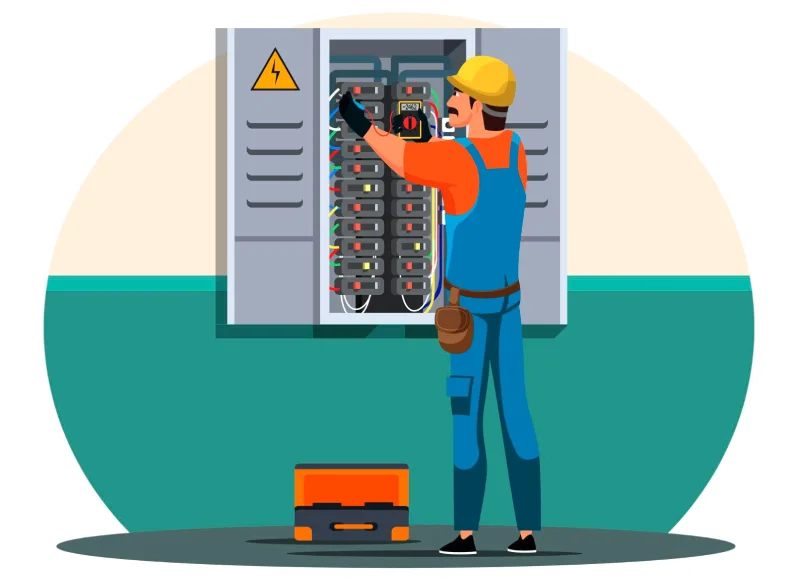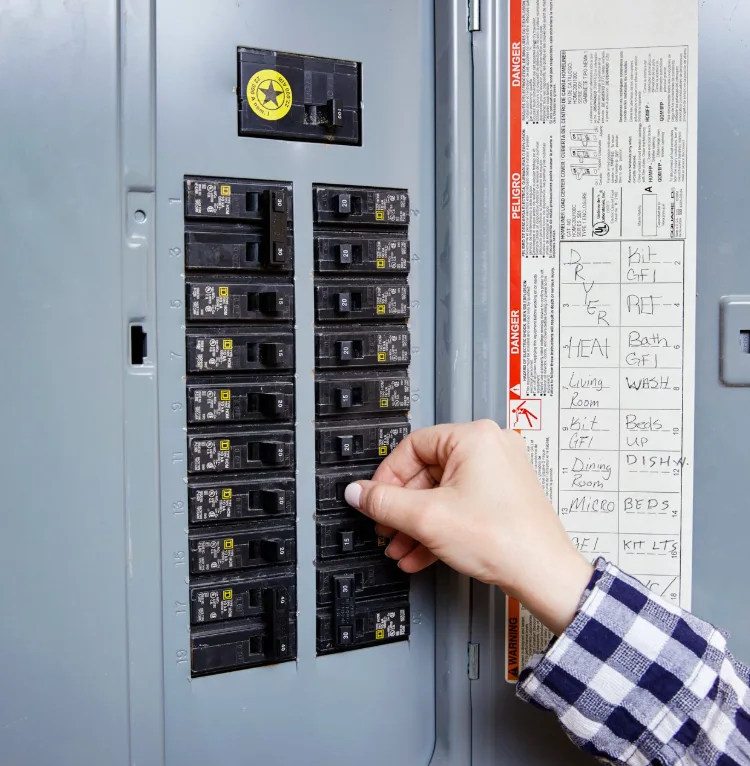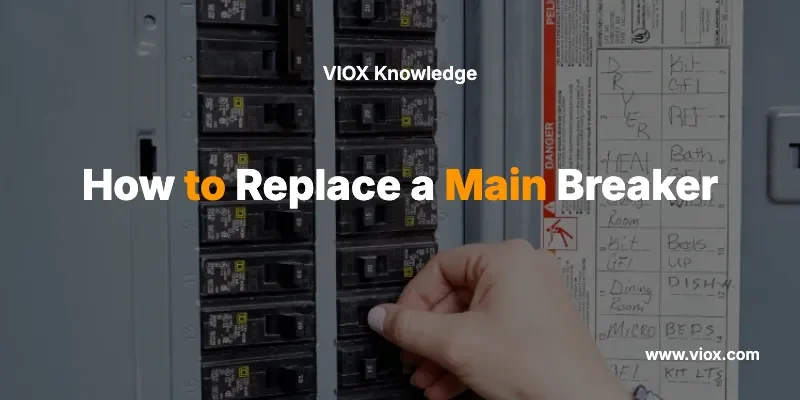⚠️ CRITICAL SAFETY WARNING: Main breaker replacement involves working with live electrical panels that can cause electrocution, fire, or death. This work typically requires permits and licensed electricians in most jurisdictions. Always consult local codes and consider professional installation for safety and compliance.
Replacing a main breaker is a critical electrical upgrade that protects your entire home’s electrical system. You need to understand when replacement is necessary, safety requirements, and proper installation procedures to ensure your family’s safety and code compliance.
What Is a Main Breaker and When Does It Need Replacement?

A main breaker is the primary electrical disconnect switch that controls power flow to your entire electrical panel. Located at the top of most residential panels, it acts as the first line of protection against electrical overloads and provides a means to shut off all power to your home.
Signs your main breaker needs replacement:
- Frequent tripping without obvious overloads
- Burning smell or visible burn marks around the megszakító
- A megszakító forró tapintású
- Breaker won’t stay in the “ON” position
- Age exceeding 25-30 years (especially in Federal Pacific or Zinsco panels)
- Crackling or sparking sounds when switching
Hol található a főkapcsoló? Teljes körű útmutató háztulajdonosoknak
Main Breaker Types Comparison
| Megszakító típusa | Áramerősség-tartomány | Legjobb | Biztonsági jellemzők | Költségek Tartomány |
|---|---|---|---|---|
| Standard Thermal-Magnetic | 100A-200A | Most residential homes | Túláramvédelem | $75-$150 |
| GFCI Fő megszakító | 100A-200A | Wet locations, pools | Föld hibája védelem | $200-$400 |
| Arc Fault Main Breaker | 100A-200A | Modern code compliance | Áramköri hiba észlelése | $300-$500 |
| High-Amperage (225A+) | 225A-400A | Large homes, heavy loads | Enhanced capacity | $400-$800 |
Biztonsági követelmények és a szabályzatoknak való megfelelés
🚨 PERMIT REQUIREMENTS: Most jurisdictions require electrical permits for main breaker replacement. Contact your local building department before beginning work.
Nemzeti Elektromos Code (NEC) Követelmények:
- Work must comply with NEC Article 230 (Services)
- Proper grounding and bonding required
- GFCI protection may be required in certain installations
- Professional inspection typically required
Personal Protective Equipment (PPE) Required:
- Safety glasses with side shields
- Insulated electrical gloves (Class 0 minimum)
- Non-conductive footwear
- Flame-resistant clothing
- Insulated tools rated for electrical work

When to Call a Professional vs. DIY Considerations
Call a Licensed Electrician If:
- Your area requires professional installation by code
- You’re uncomfortable working with electrical systems
- The panel is Federal Pacific, Zinsco, or other recalled brands
- Meter disconnect is required
- Grounding system needs updating
- You lack proper tools or experience
DIY May Be Possible If:
- Local codes permit homeowner electrical work
- You have electrical experience and proper tools
- The existing panel is in good condition
- No meter disconnect is required
- You can obtain proper permits
Step-by-Step Main Breaker Replacement Process
⚠️ WARNING: This process involves deadly voltages. Consider this educational information only. Professional installation is recommended.
Phase 1: Preparation and Safety
- Contact utility company to discuss power disconnection if meter disconnect is required
- Obtain electrical permit from your local building department
- Gather proper tools:
- Szigetelt csavarhúzók
- Kábelcsupaszítók
- Voltage tester (non-contact and multimeter)
- Torque wrench
- Wire nuts or connectors
- Turn off all individual breakers in the panel
- Ellenőrizze, hogy ki van-e kapcsolva az áram using a voltage tester
Phase 2: Main Breaker Removal
- Photograph existing connections for reference
- Test for voltage at main breaker terminals (should read 240V if live)
- Távolítsa el a panelburkolatot carefully to avoid contact with live parts
- Disconnect neutral and ground wires from main breaker if connected
- Remove hot wire connections from main breaker terminals
- Unclip old main breaker from panel bus bars
Phase 3: New Breaker Installation
- Verify new breaker compatibility with your panel manufacturer
- Align new breaker with bus bars and press firmly until fully seated
- Reconnect hot wires to new breaker terminals using proper torque specifications
- Reconnect neutral and ground wires if applicable
- Ellenőrizze az összes csatlakozást are tight and properly seated
Phase 4: Testing and Inspection
- Replace panel cover ensuring no wires are pinched
- Turn on main breaker slowly and listen for unusual sounds
- Test individual breakers one at a time
- Verify proper operation with voltage tester
- Schedule electrical inspection as required by local code
Expert Tips for Safe Installation
💡 PROFESSIONAL TIP: Always use a breaker specifically designed for your panel brand. Cross-compatibility can create safety hazards and code violations.
💡 PROFESSIONAL TIP: Torque connections to manufacturer specifications. Under-tightened connections cause arcing and overheating; over-tightened connections can damage equipment.
💡 PROFESSIONAL TIP: Take photos before disconnecting anything. Proper wire identification prevents dangerous mistakes during reconnection.
Main Breaker Selection Guide
Choosing the Right Amperage:
- 100A: Small homes, minimal electrical loads
- 150A: Average homes with standard appliances
- 200A: Modern homes with electric heat, A/C, multiple appliances
- 225A+: Large homes or heavy electrical loads
Panel Compatibility Requirements:
- Breaker must match exact panel manufacturer (D. négyzet, GE, Siemens, etc.)
- Verify bus bar configuration and mounting style
- Check available space and clearance requirements
- Ensure proper voltage rating (120/240V for residential)
Gyakori problémák és hibaelhárítás
| Probléma | Lehetséges ok | Megoldás |
|---|---|---|
| Breaker won’t stay on | Internal damage, overload | Replace breaker, check for overloads |
| Burning smell | Laza kapcsolatok, túlterhelés | Shut off immediately, call electrician |
| No power after installation | Incorrect wiring, defective breaker | Verify connections, test breaker |
| Breaker trips immediately | Rövidzárlat, ground fault | Check wiring, use GFCI breaker if required |
Cost Analysis and Professional Considerations
DIY Cost Breakdown:
- Main breaker: $75-$500 (depending on type and amperage)
- Permits: $50-$200
- Tools (if needed): $100-$300
- Total DIY Cost: $225-$1,000
Professional Installation Cost:
- Labor: $200-$500
- Materials: $75-$500
- Permits: $50-$200
- Total Professional Cost: $325-$1,200
💡 EXPERT RECOMMENDATION: The cost difference between DIY and professional installation is often minimal when factoring in permit requirements, tool costs, and safety risks. Professional installation ensures code compliance and warranty coverage.
Gyakran Ismételt Kérdések
How long does main breaker replacement take?
Professional installation typically takes 2-4 hours, including testing and cleanup. DIY projects may take longer due to permit requirements and inspection scheduling.
Can I replace a main breaker without shutting off power at the meter?
In most cases, no. Main breaker replacement usually requires complete power disconnection, which often involves utility company coordination for meter disconnect.
Will my homeowner’s insurance cover damage from DIY electrical work?
Many insurance policies exclude coverage for unpermitted electrical work or DIY installations that don’t meet code requirements. Check your policy before proceeding.
What’s the difference between a main breaker and a main disconnect?
A main breaker provides both disconnection and overcurrent protection, while a main disconnect (switch) only provides disconnection without overcurrent protection.
How often should main breakers be replaced?
Quality main breakers can last 25-40 years with proper maintenance. However, panels from certain manufacturers (Federal Pacific, Zinsco) should be replaced regardless of age due to safety concerns.
Can I upgrade from 100A to 200A service with just a breaker replacement?
No. Service upgrades require new meter base, panel, and often utility line upgrades. This is always professional work requiring permits and utility coordination.
What happens if I use the wrong type of breaker for my panel?
Using incompatible breakers creates serious safety hazards including fire risk, electrocution danger, and code violations. Always use manufacturer-approved breakers.
Do I need special tools for main breaker replacement?
Yes. Essential tools include insulated electrical tools, voltage testers, and often torque wrenches for proper connection tightening. Standard tools are insufficient and dangerous.
Safety Checklist and Final Recommendations
Before Starting Any Work:
- ✅ Verify local permit requirements
- ✅ Confirm your skill level matches project complexity
- ✅ Gather all required PPE and tools
- ✅ Plan for professional inspection
- ✅ Consider professional installation for safety and warranty
🚨 REMEMBER: Main breaker replacement involves potentially lethal voltages. When in doubt, hire a licensed electrician. Your safety and your family’s safety are worth more than potential savings.
Professional installation ensures:
- Code compliance and permit handling
- Proper safety procedures
- Garanciális fedezet
- Insurance protection
- Expert troubleshooting if problems arise
For complex electrical work like main breaker replacement, investing in professional installation provides peace of mind and long-term safety that DIY approaches cannot match.
Kapcsolódó
Teljes útmutató az áramkör-megszakító szimbólumaihoz
Hol található az elosztódoboz, és hogyan találja meg?
Mi az a miniatűr áramkör-megszakító (MCB): Teljes körű útmutató a biztonsághoz és a kiválasztáshoz


